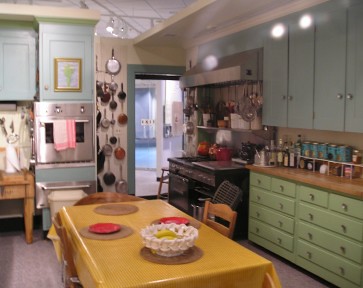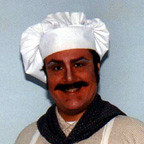It is no exaggeration to assert that Julia was one of the greatest influences on American culture in the 20th century. Even today, we benefit from the quality, excitement, and variety of culinary adventures she started in the 1960s.
If you think back in American history, the time of the Eisenhower Administration was when Americans were learning to be peacetime Americans in the post-World War II, post-Korean War era. All of that military scientific and engineering ingenuity was being adapted to domestic uses. Fabulous new inventions helped the housewife save time in the kitchen. Convenience foods began to transform the American palate as exciting things like artificial creamer, frozen TV dinners, frozen fish sticks, Cheese Whiz, Lipton's Soup Mix, Sweet 'N Low, Rice-a-Roni, and McDonald's Restaurant franchises were invented. "Fancy" restaurants were known for their exciting menus of grilled steak and baked potatoes and grilled steak and baked potatoes. Other courses would typically be shrimp cocktail (boiled shrimp arranged around a small bowl of ketchup and horseradish "cocktail" sauce) and a wedge of Iceberg lettuce with a slice of tomato and some blue cheese (for the bold) or orange-colored "French" (for the rest of us) dressing. America plunged into a craving for cookie cutter sameness à la Father Knows Best or Leave It to Beaver. Into this bland conformity came Julia Child with her book Mastering the Art of French Cooking in 1961 and her Public Television series The French Chef in 1963.
Julia was an unlikely vehicle for mass cultural change. Born in 1912 to an upper middle class family, she was educated at Smith College and then joined the OSS (today known as the CIA) in World War II, where she met her husband, another OSS employee. After the war, they traveled the world with his State Department diplomatic career, eventually moving to Paris in 1948 for a new posting. It was their first meal in France after a week of dreadful shipboard food that inspired Julia's conversion to good food and good cooking. The simple goodness of fresh oysters on the half shell, sole meunière, a green salad, some crème fraîche, and a bottle of cold, crisp Pouilly Fuissé sparked Julia's revelation that food didn't have to be bland and boring. Soon thereafter, Julia enrolled in the world-renowned Le Cordon Bleu cooking school in Paris and learned to cook. Eventually she met two French women, the three of them started a cooking school in Paris, and they began a ten-year collaboration to write a French cookbook targeted at the American audience. It was finally published in 1961, and the rest is history.
The French Chef lasted from 1963 through 1966. One of my earliest childhood memories was watching those black and white PBS shows with the big, tall (she was 6'2"), hooty-voiced woman cooking yummy food with funny (French) names. After a round of reruns, a color version debutted in 1970, with Julia staunchly staying with PBS and the "educational people" instead of crossing over to network television. Then over the decades, a succession of Julia Child cooking shows—all with companion cookbooks—hit the PBS stations, including Julia Child and Company, Julia Child and More Company, Dinner at Julia's, Baking with Julia, Cooking with Master Chefs, In Julia's Kitchen with Master Chefs, and Jacques and Julia at Home. Julia was the first television chef and celebrity, and she paved the way for Iron Chef, Emeril, and Martha the Criminal. Her shows—mainstays of Saturday morning PBS programming—inspired Americans to raise their culinary standards and to be more adventuresome in trying and tasting cuisines from around the world.
Eventually, age began to overtake Julia. In 2001, she announced that she was moving to sunny southern California to an assisted living home, and that she was donating her famous kitchen in her Cambridge, Massachusetts, home to the Smithsonian Institution here in Washington. In August of 2002, in time for a grand celebration of Julia's 90th birthday, the Smithsonian opened the kitchen exhibit at the National Museum of American History. There was a birthday party and a special $350 per person tribute birthday dinner created for Julia by Chef Ris Lacoste at her landmark Georgetown restaurant, 1789. Then, last year, just two days shy of her 92nd birthday, Julia died, leaving her indelible imprint on American culture.
Requiescat in pace, Julia. We miss you.

Julia's kitchen at the National Museum of American History

No comments:
Post a Comment